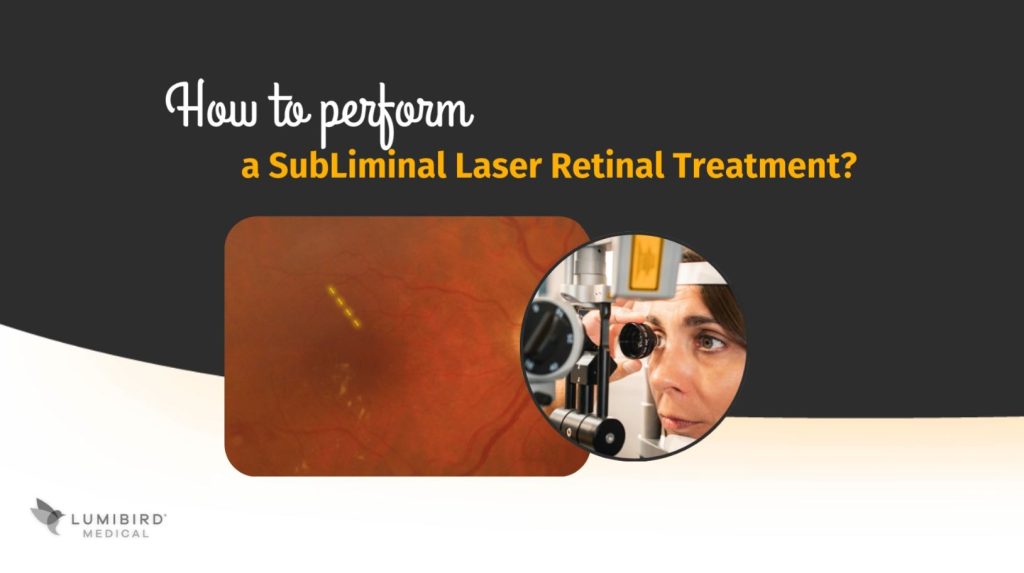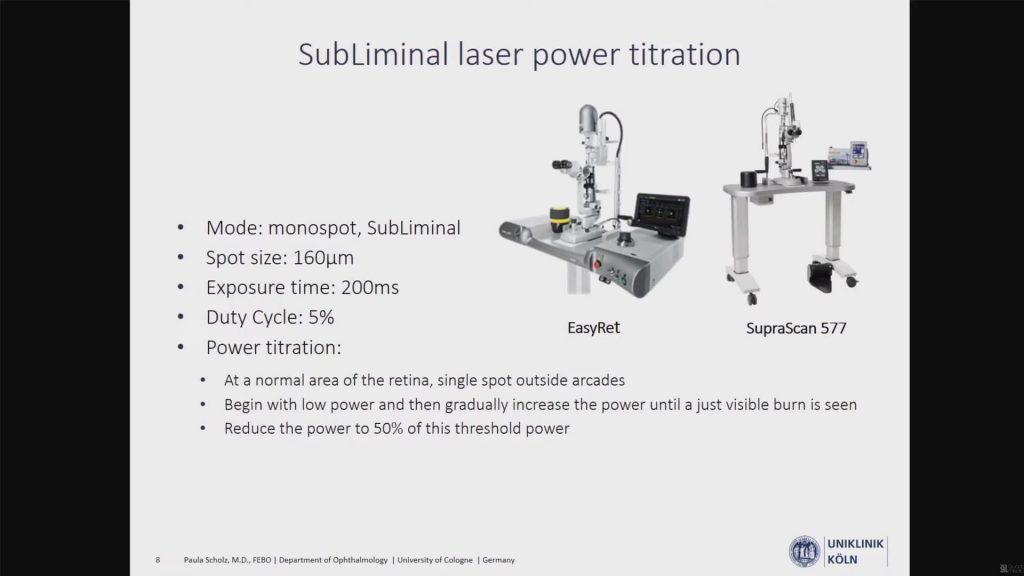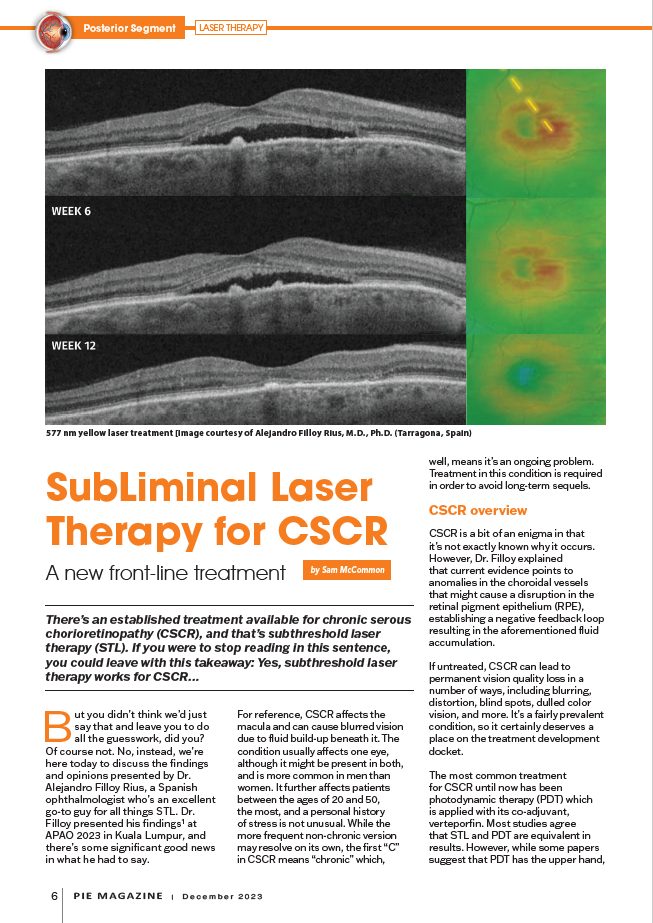Subliminal Laser Therapy is a Macular treatment
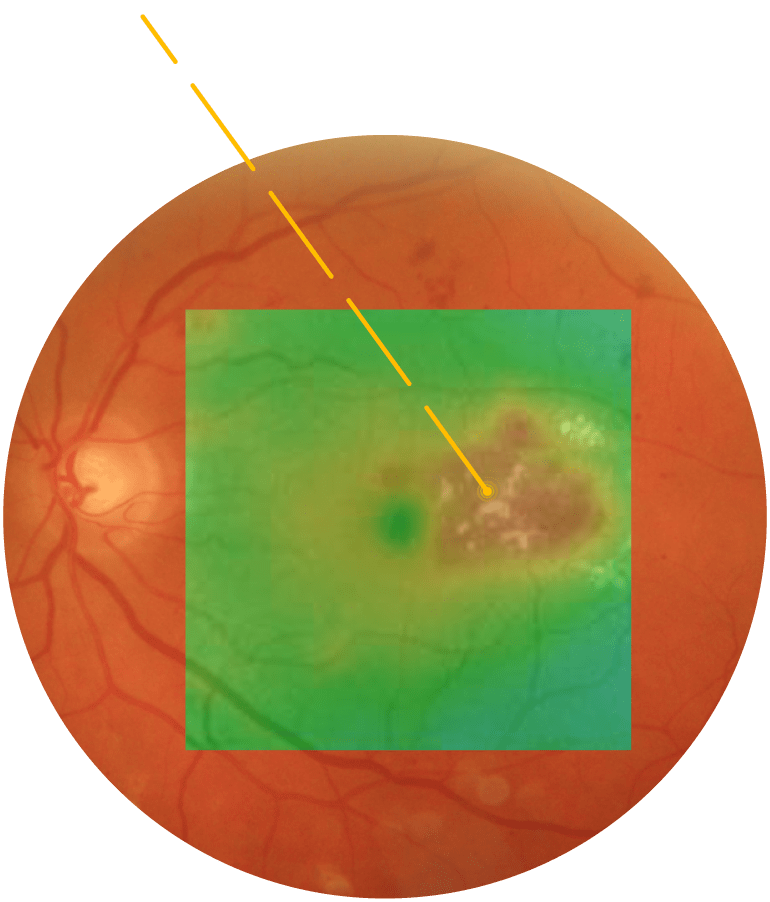
A macular treatment
SubLiminal laser therapy is currently most commonly used in cases of retinal vascular diseases with macular edema, such as diabetic macular edema (DME) or central serous chorioretinopathy (CSR).
Other macular pathologies can also be considered like macular edema secondary to branch retinal vein occlusion (BRVO) or polypoidal choroidal vasculopathy (PCV).
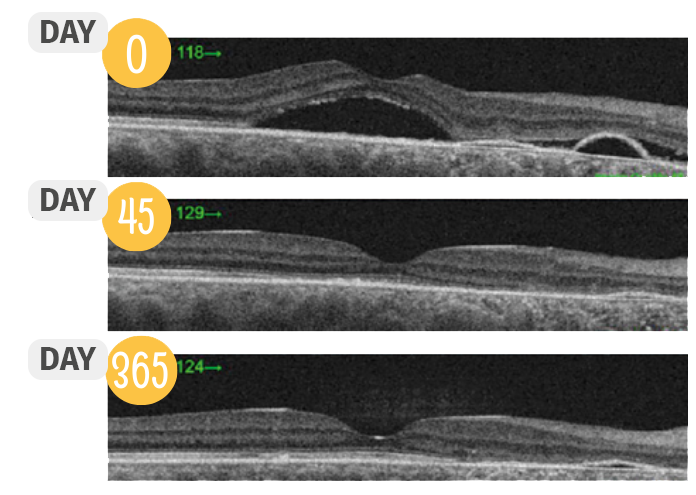
CCSC treatment with Subliminal Laser Therapy from Easyret®
49 year old patients with a history of CCSC in his right eye treated years ago with PDT. He presents with a recurrence of his condition with VA 20/50.
Receives Subliminal treatment: 1090 spots, 160 microns, at 300mW (titrated at 850), encompassing most of the macular area, sparing the foveal area.
- 6 weeks after VA is 20/30 with complete SRF resolution and no visible reaction on autofluorescence.
- Next follow up visit, 12 weeks after treatment: VA 20/25.
- Final follow up visit, 12 months after treatment: VA 20/22, with a progressively more reconstituted outer retina.
STL laser was fully effective to resolve this CSCC recurrence in a context of unavailability of PDT.

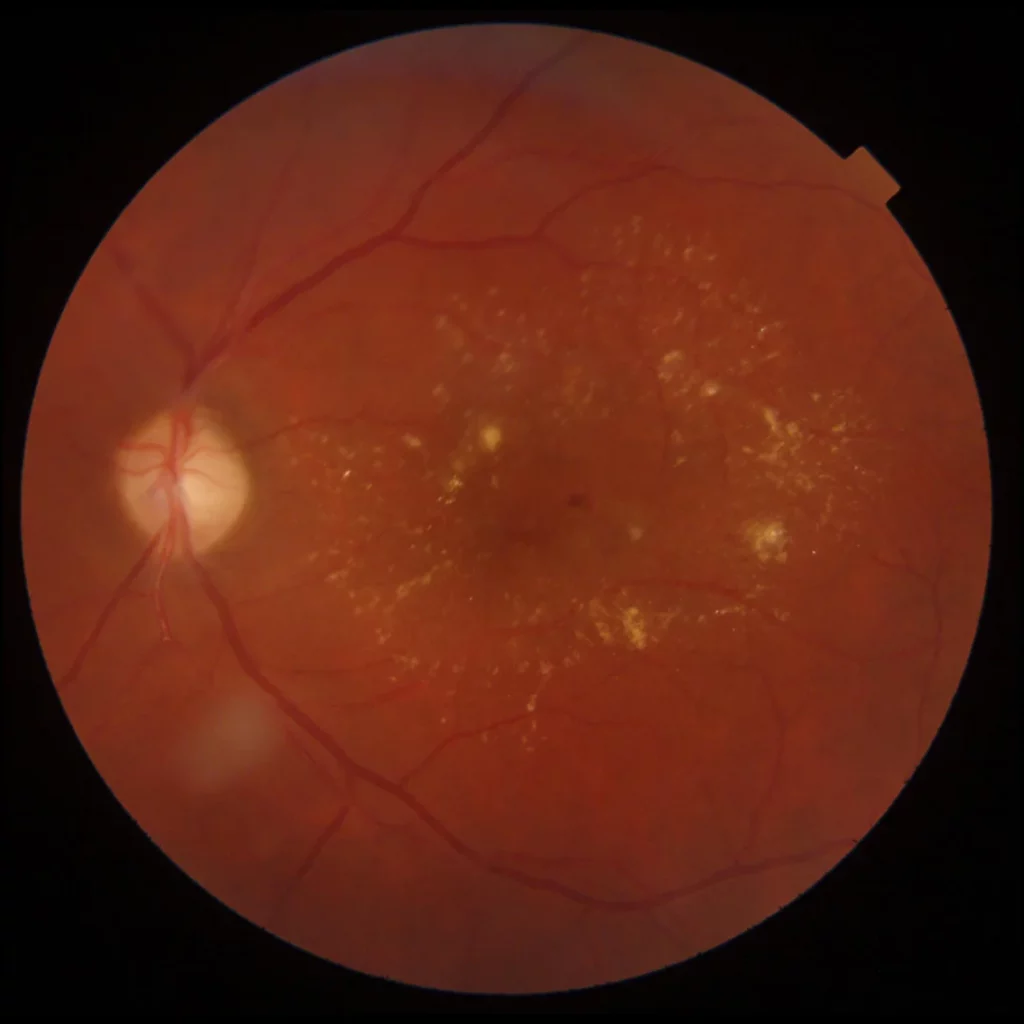
Macular telangiectasia Subliminal laser treatment
MacTel SubLiminal laser treatment:
51-year man, referred after long history of unsuccessful treatments (antivegf, steroids)
Subliminal panmacular treatment: 730 spots 160 mic 250 mW + 12 focal spots 120 mic 50 mW over the main vessel malformations.
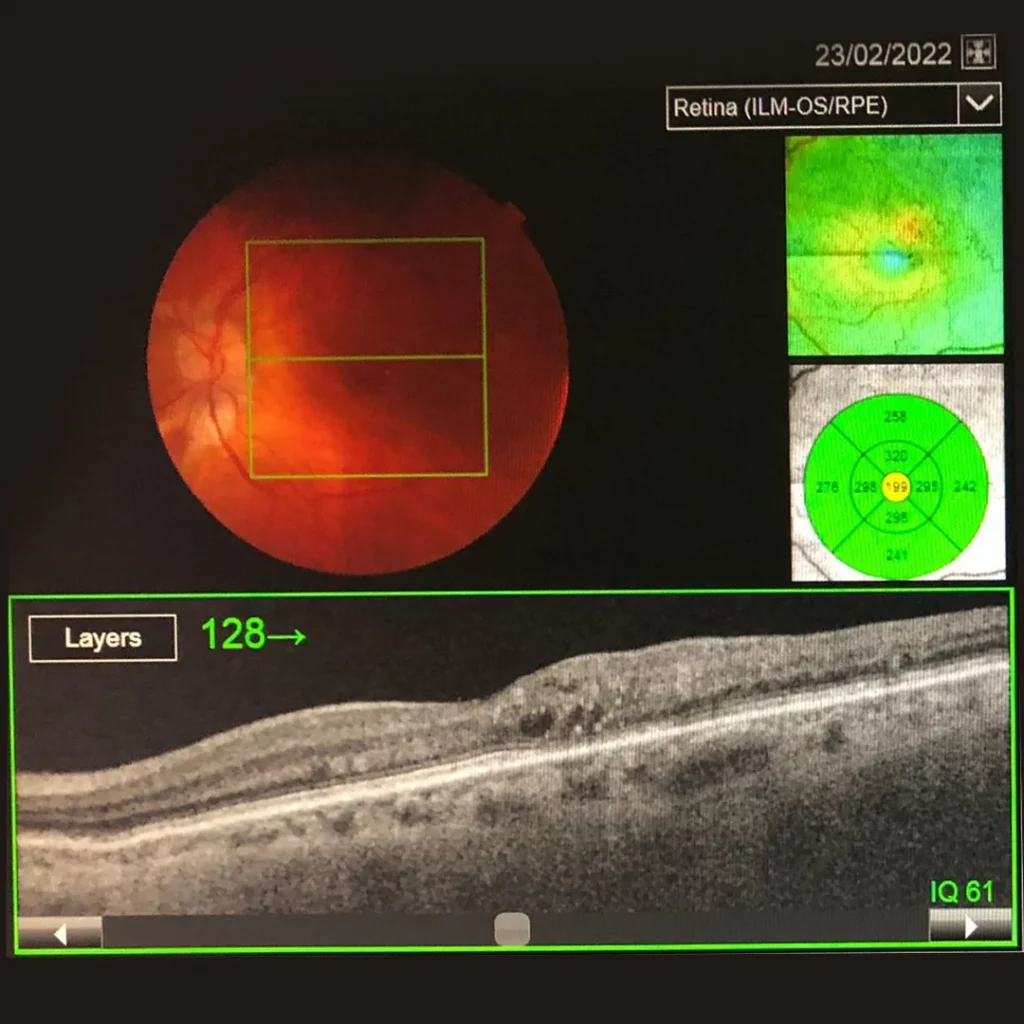
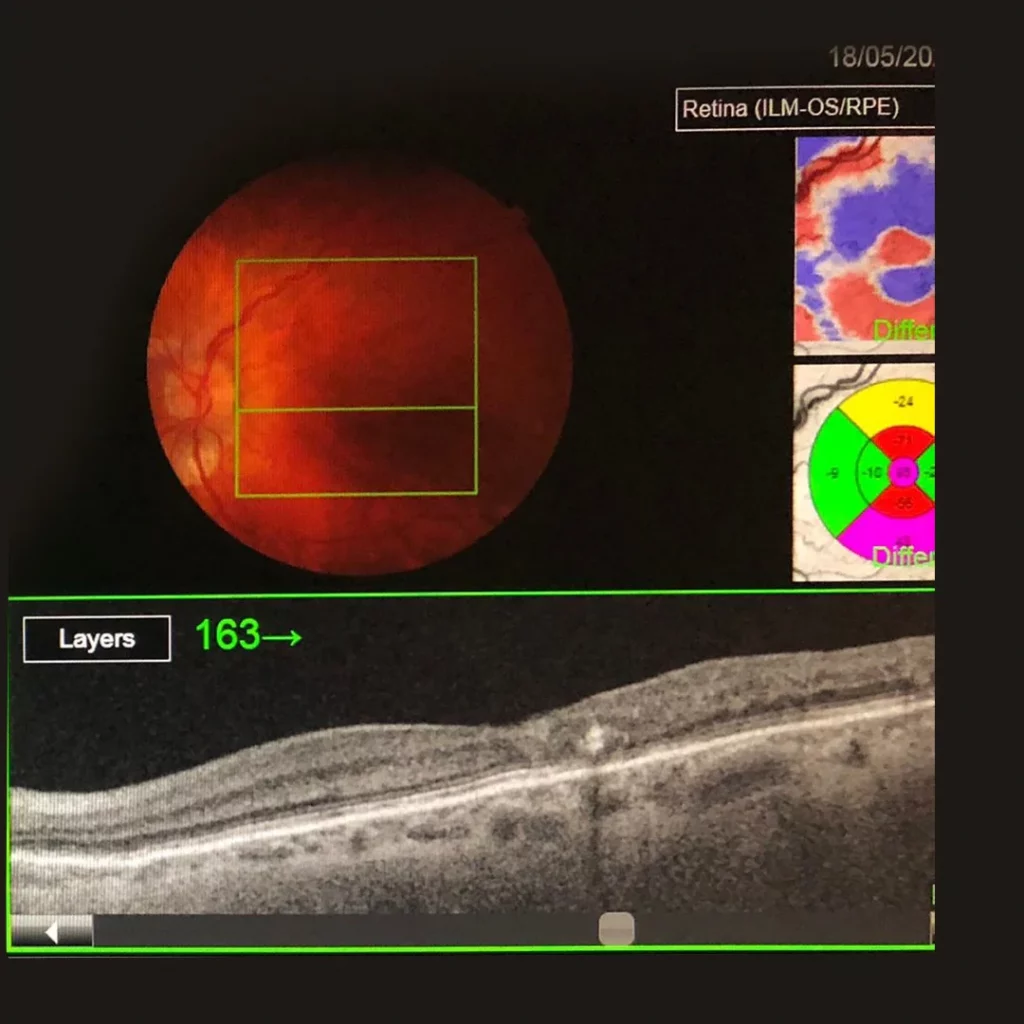
Diabetic Macular Edema with SubLiminal Laser Therapy
This is a 65-year-old patient diagnosed with MacTel 1 in his left eye.
Dr Alejandro Filloy Rius, Tarragona, Spain performed Subliminal laser treatment, 250 spots 160 mic 300 mW.
12 weeks after, without additional treatment, improvement is obvious.
VA remained stable at 20/25.
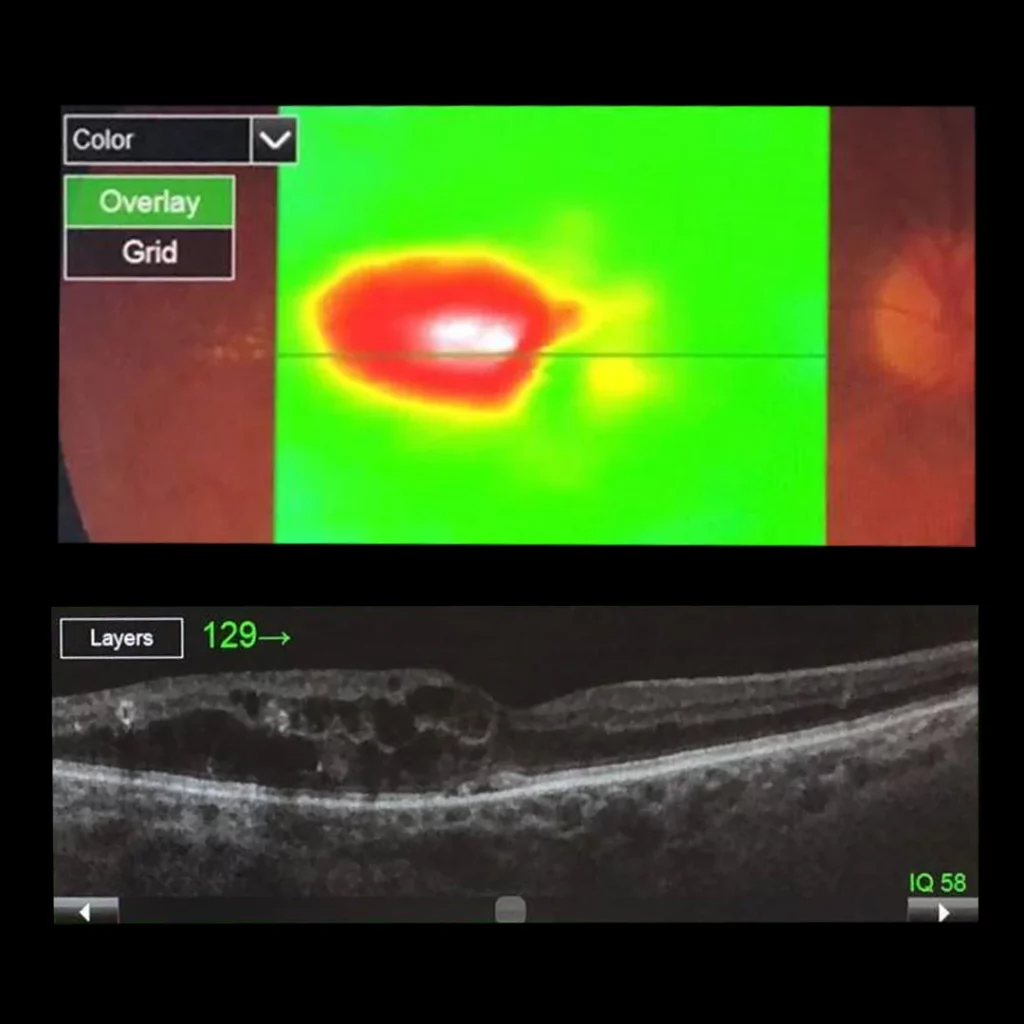
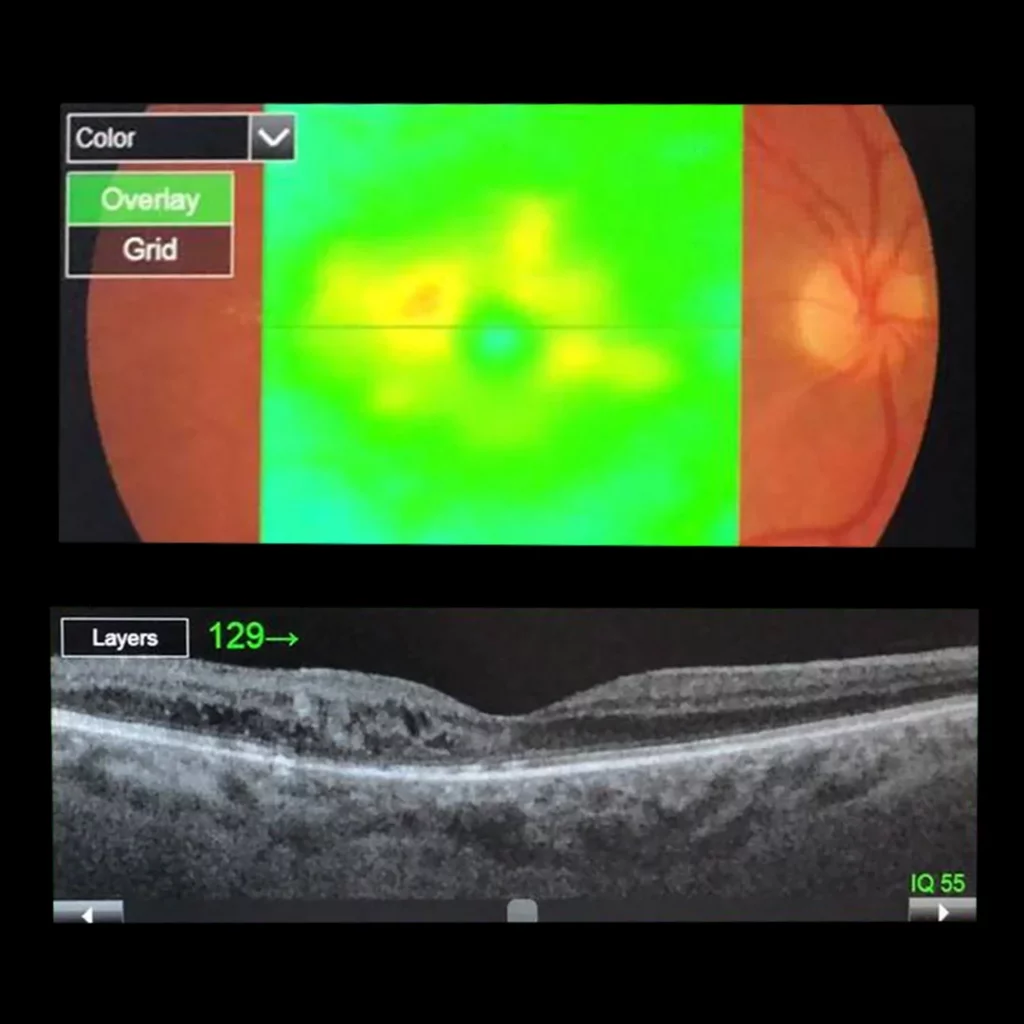
Combination of 577nm SubLiminal laser and 577nm focal laser
This is a 60 year-old diabetic patient who presents with VA 20/30.
He was treated with a combination of 577nm SubLiminal laser and 577nm Focal laser :
- 577 Subliminal laser: 550 laser spots (160µ / 0,2s / 400mW @ 5% DC) over the whole edematous area
and - 577nm thermal treatment:8 focal spots (100 µ / 0,1s / 50 mW) directed at the largest aneurysms.
4 months after, improvement on OCT is obvious. VA 20/25 and laser invisible both in oct and autofluorescence.
Physicians
Present patient cases treated with Subliminal Laser Therapy
Treatment guidelines
SubLiminal laser therapy is a method of delivering laser energy to the retina, producing a bio-stimulation effect, while minimizing permanent thermal damage to the retinal tissue. The concept involves delivery of a “train” of laser pulses, each pulse separated by sufficient time to allow heat dissipation and reduce permanent damage to the retina. Unlike conventional macular laser treatment, there is no visible scarring on clinical examination, OCT or angiogram.
Refer below to the recommended SubLiminal laser treatment guidelines prepared by Victor Chong, MD (UK).
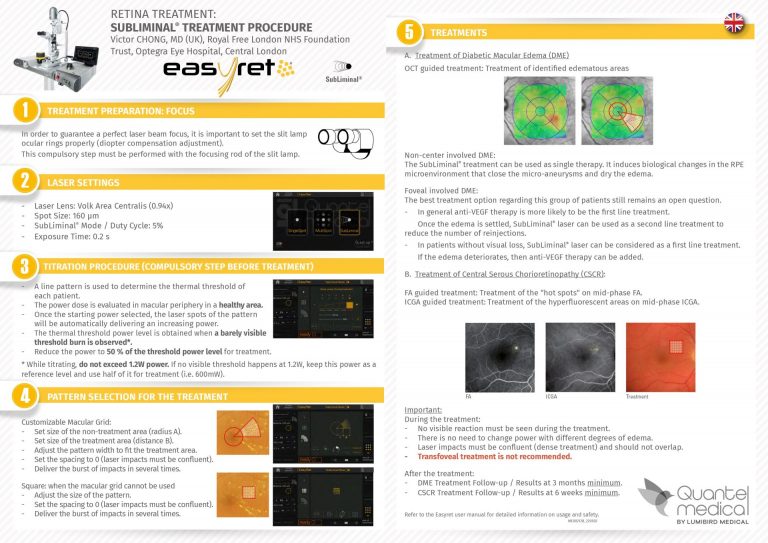
Retina Treatment: Subliminal Treatment Procedure
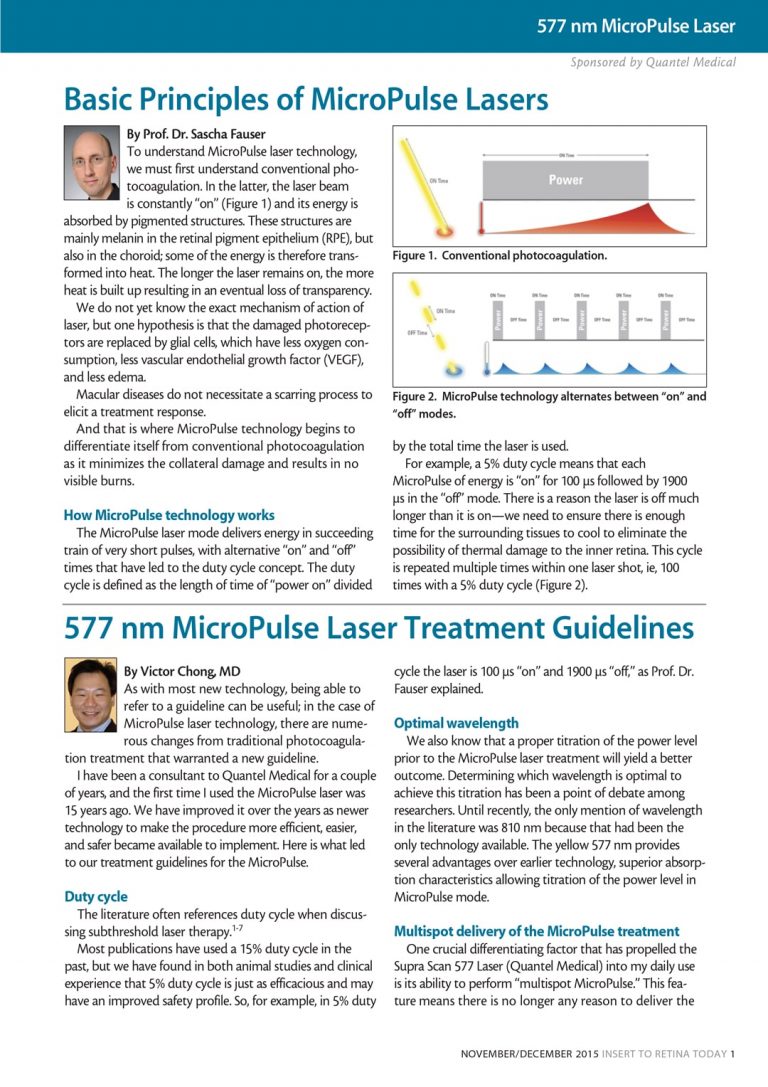
Basic Principles of MicroPulse Lasers
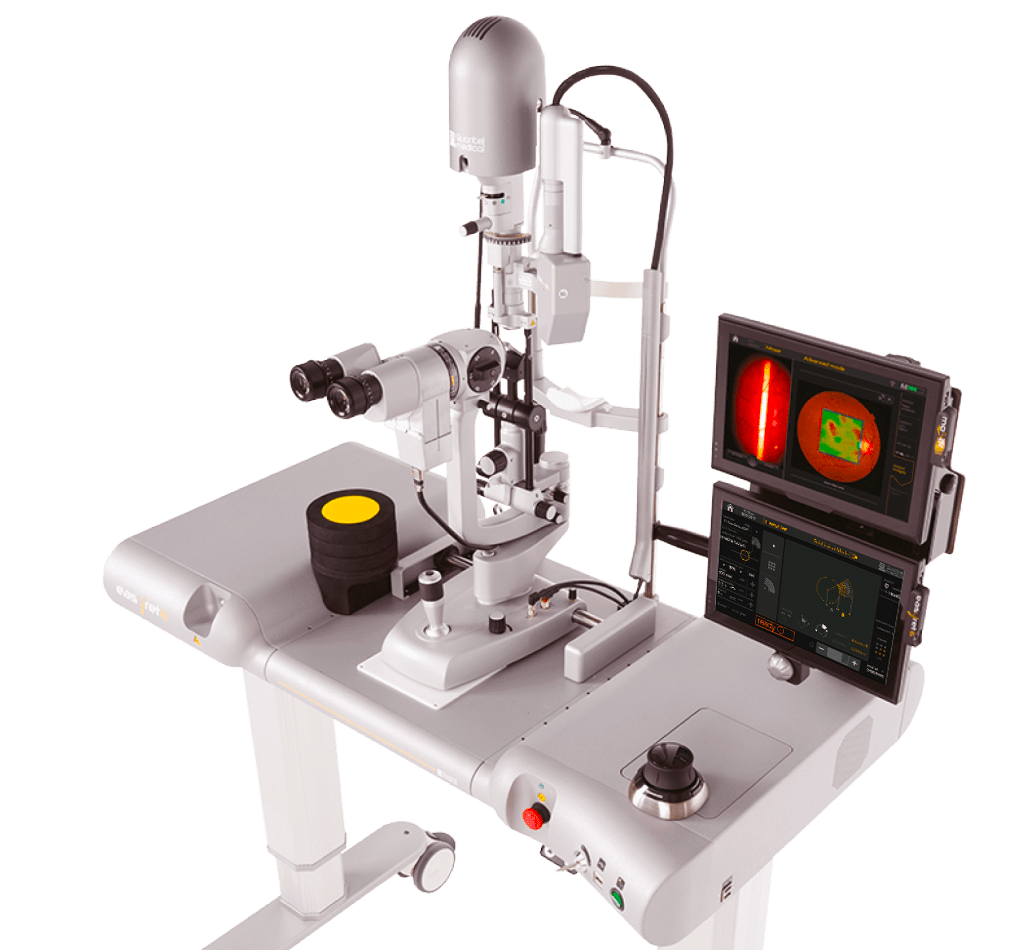
Clinical data
Central Serous Chorioretinopathy (CSC)
Central serous chorioretinopathy (CSC) is one of the most common retinal causes of vision loss. It is characterized by serous detachment of the neurosensory retina secondary to one or more focal lesions of the retinal pigment epithelium (RPE)1. This pathology ranks among the most common vision-threatening retinopathies after AMD, diabetic retinopathy and branch retinal vein occlusion2.
In acute CSC, the detachment is caused by a focal leak in the RPE. It usually resolves spontaneously within a few weeks3. However, chronic CSC can lead to permanent structural damage and often pronounced loss of central vision456.
Different treatment options are available, but there is no “gold standard” treatment for chronic CSC7:
- Traditional thermal photocoagulation can be used for extrafoveal leakages, but it is destructive and can lead to symptomatic scotomas and choroidal neovascularization.
- PDT laser therapy can also be used, however, even when using reduced treatment settings; it has also number of side effects such as RPE atrophy, choroidal neovascularization, choriocapillaris ischemia, and transient reduction of macular function.
- Yellow 577nm SubLiminal® laser therapy seems to be a promising alternative treatment strategy8.
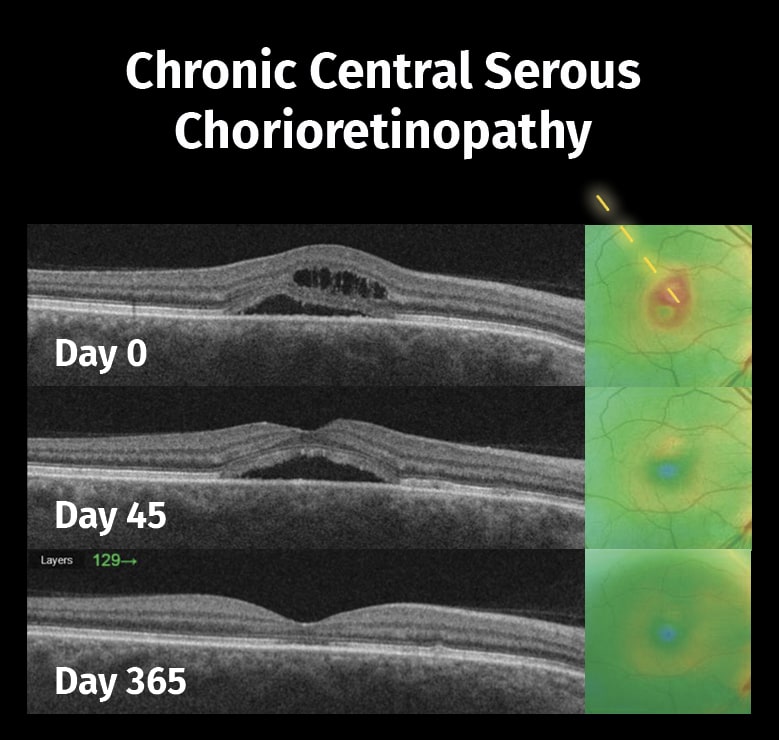
Images courtesy of Alejandro Filloy Rius, MD. Ph.D
Tarragona, Spain
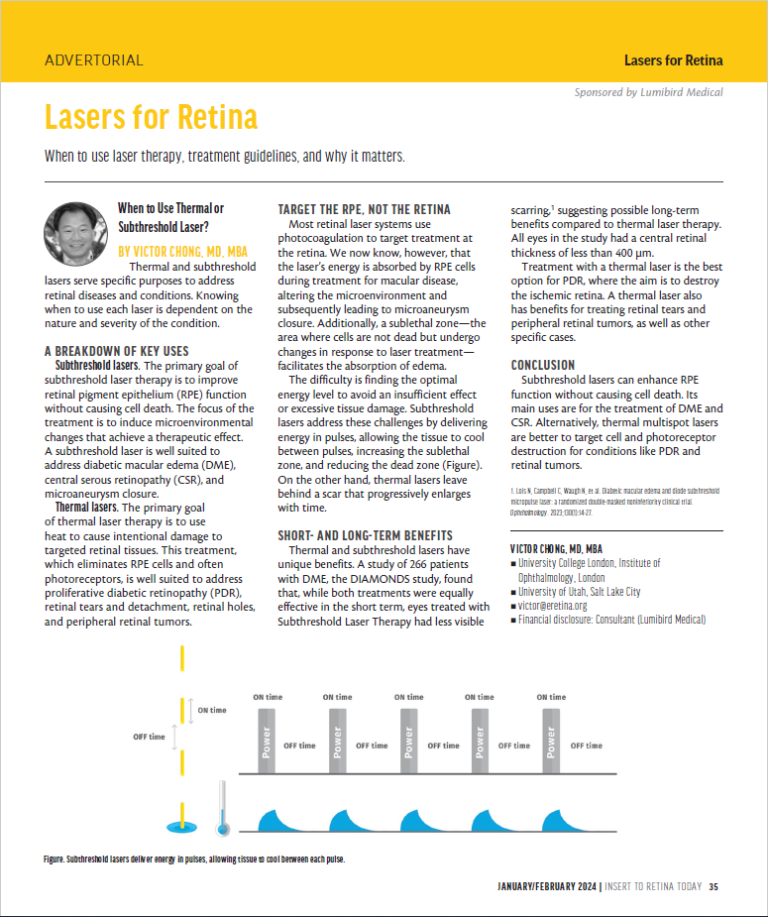
Lasers for Retina
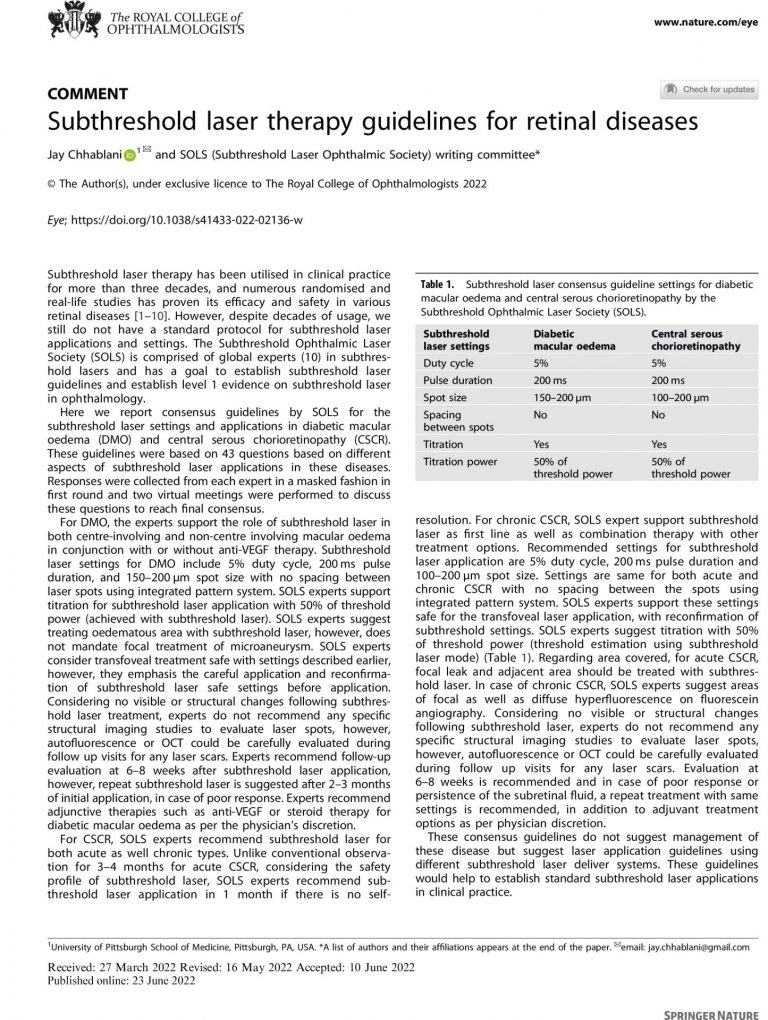
Subthreshold laser therapy guidelines for retinal diseases
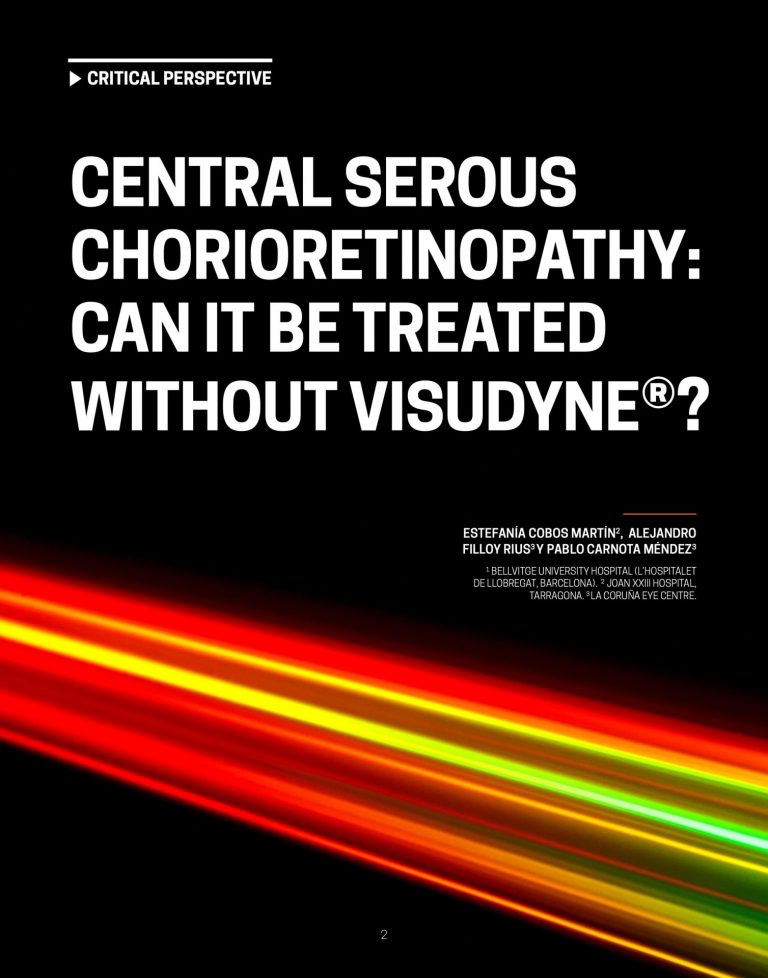
Central Serous Chorioretinopathy: Can it be treated without Visudyne?
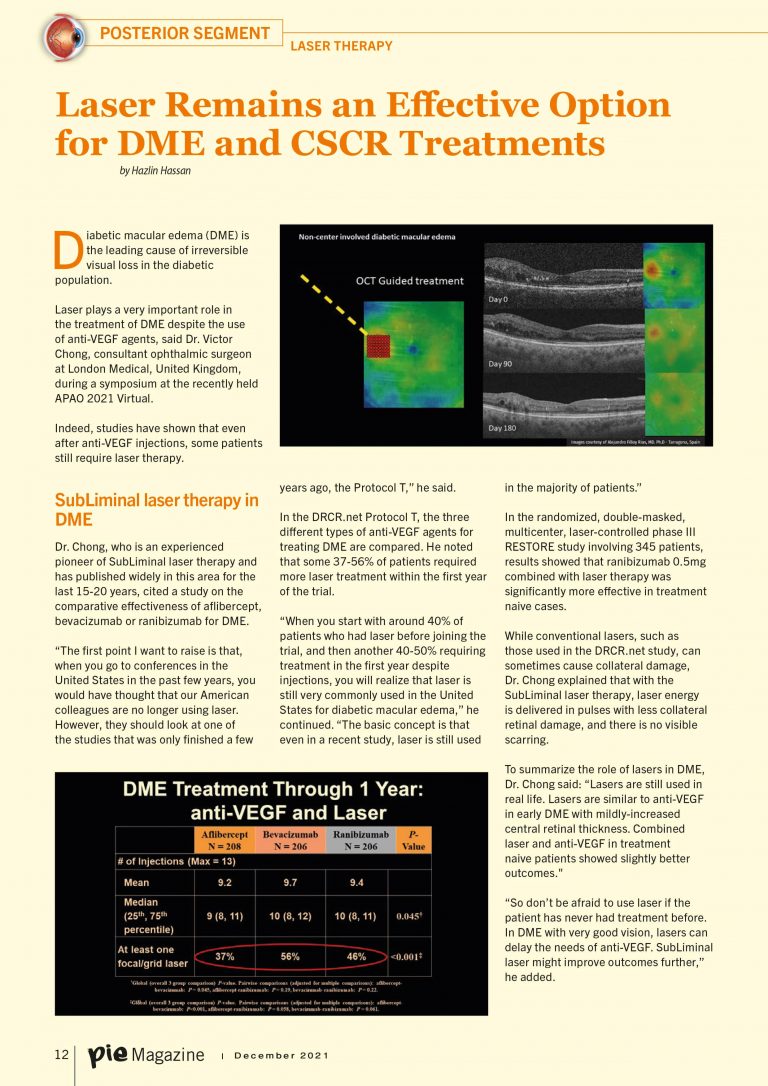
Laser Remains an Effective Option for DME and CSCR Treatments
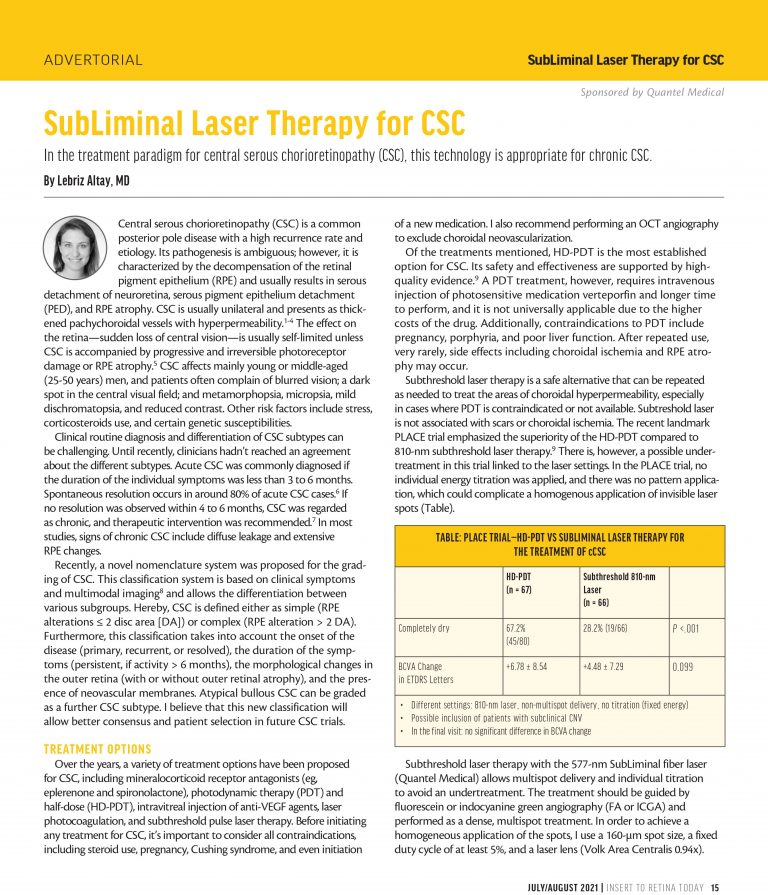
SubLiminal Laser Therapy for CSC
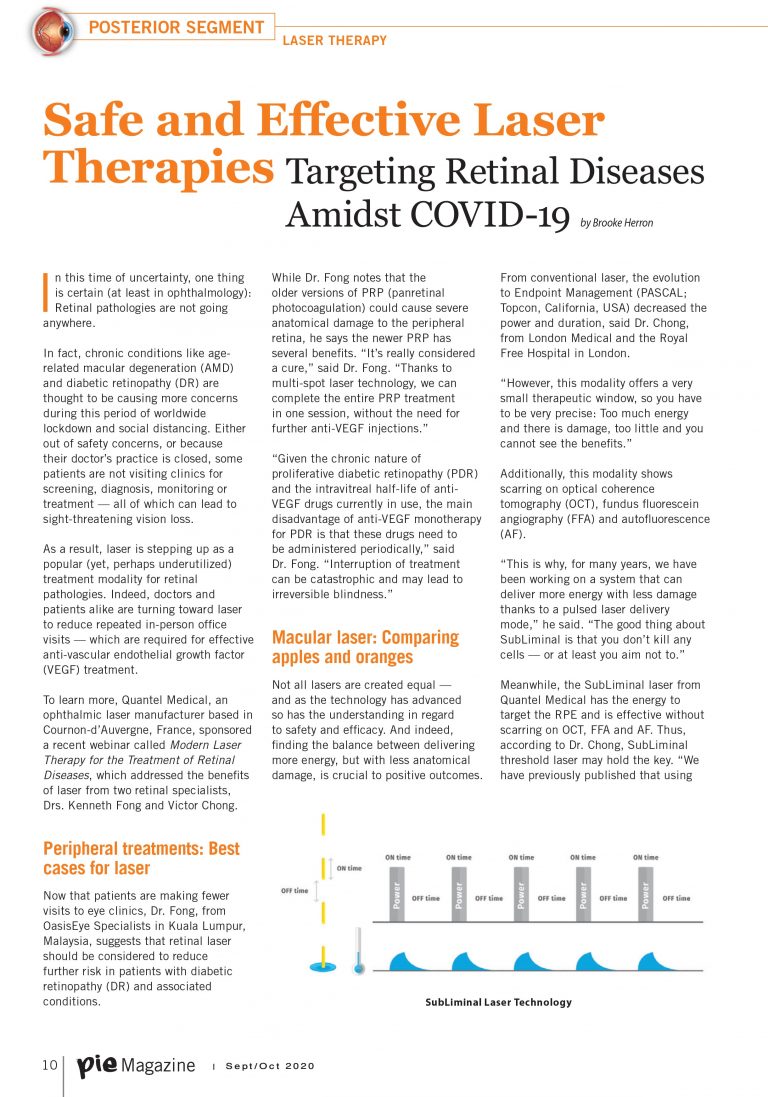
Safe and Effective Laser Therapies: Targeting Retinal Diseases Amidst COVID-19
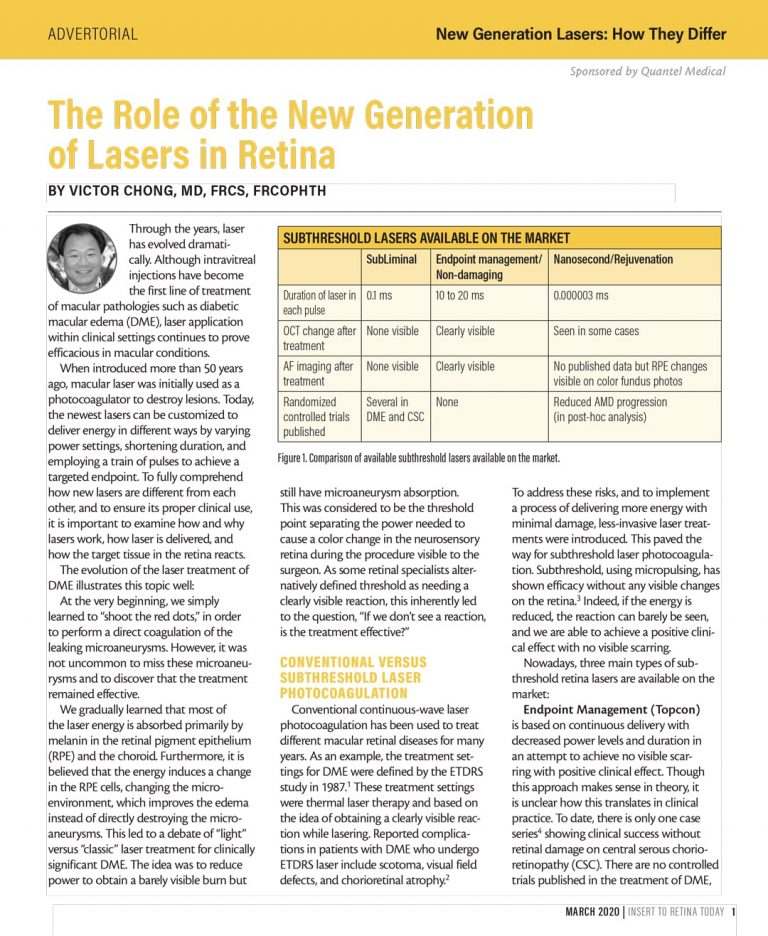
The Role of the New Generation of Lasers in Retina
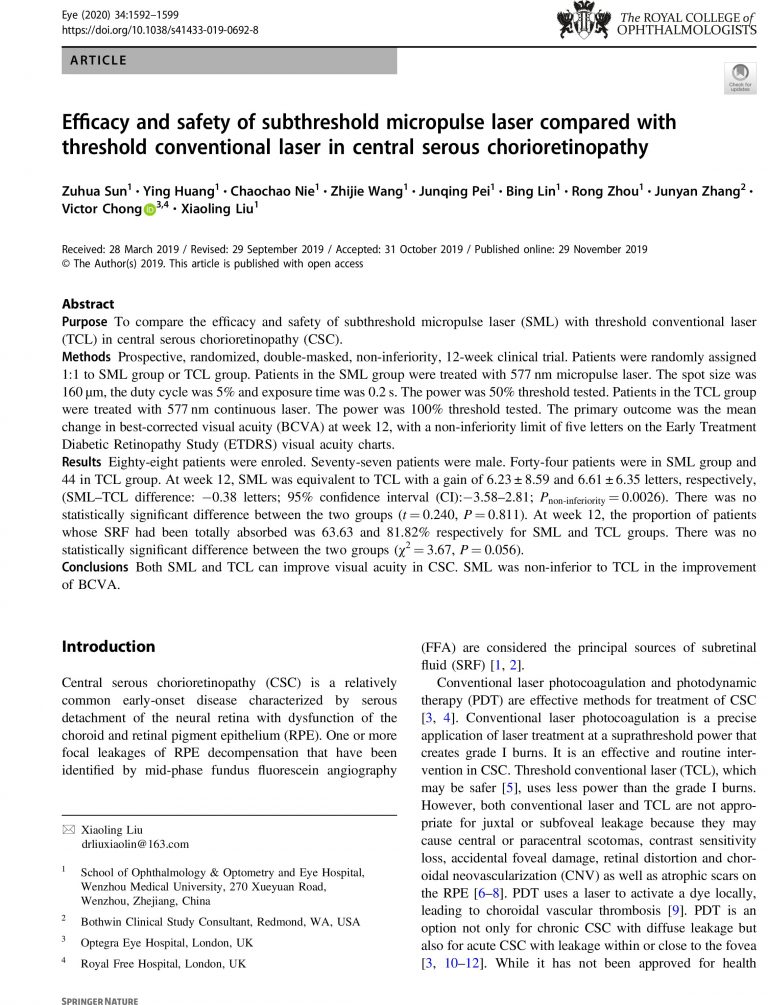
Efficacy and safety of subthreshold micropulse laser compared with threshold conventional laser in CSC
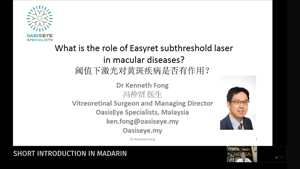
What is the role of Easyret subthreshold laser in macular diseases?
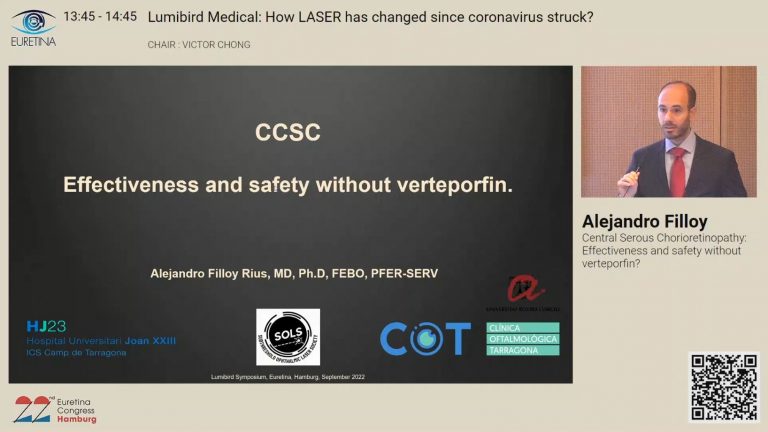
Central Serous Chorioretinopathy: effectiveness and safety without verteporfin?
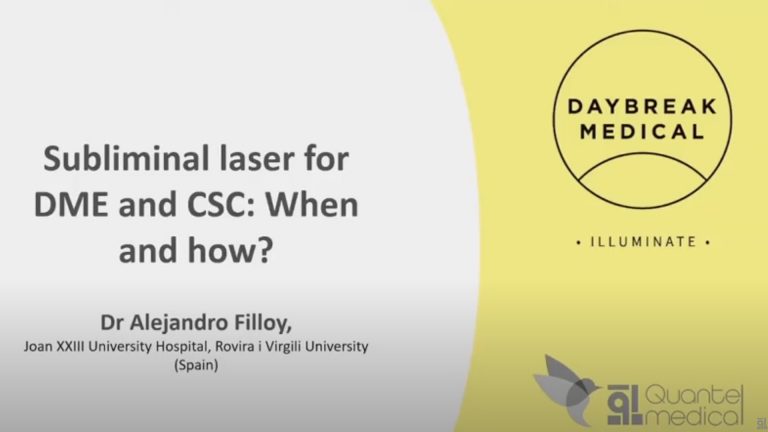
SubLiminal laser for DME and CSC: when and how?
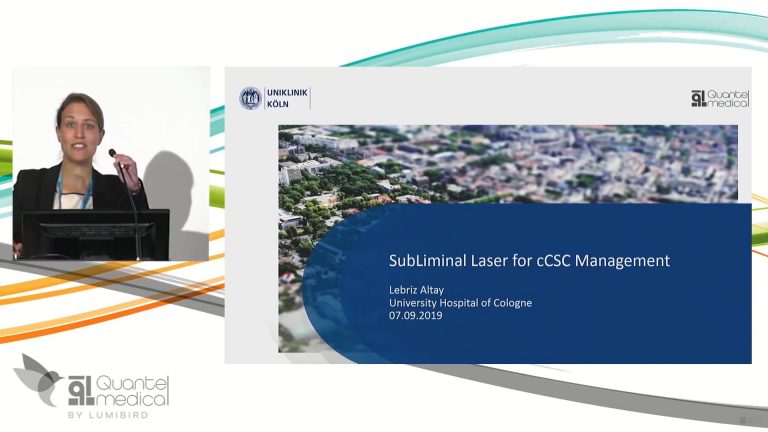
SubLiminal laser for cCSC management
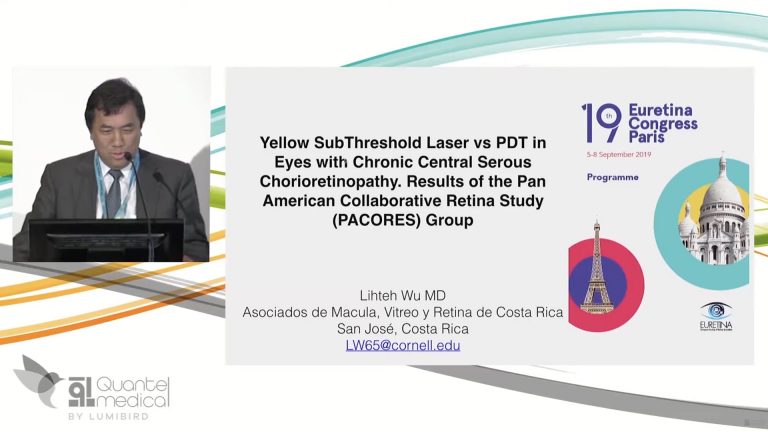
Yellow subthreshold laser vs pdt in eyes with CCSC

Subliminal laser for the treatment of Central Serous Chorioretinopathy
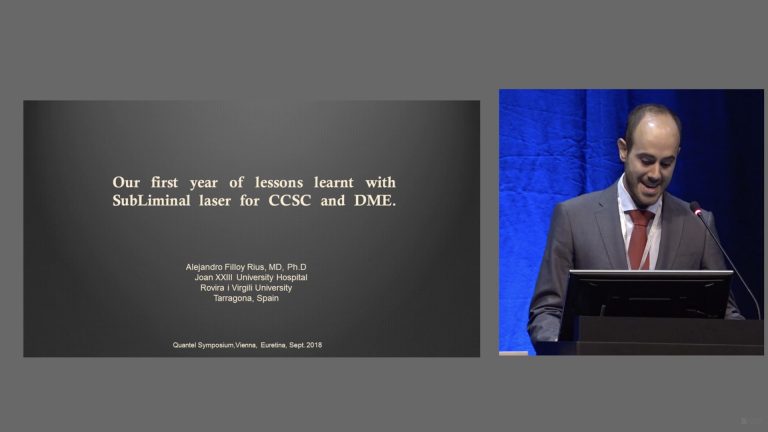
Our first year of lessons learnt with SubLiminal laser for CCSC and DME
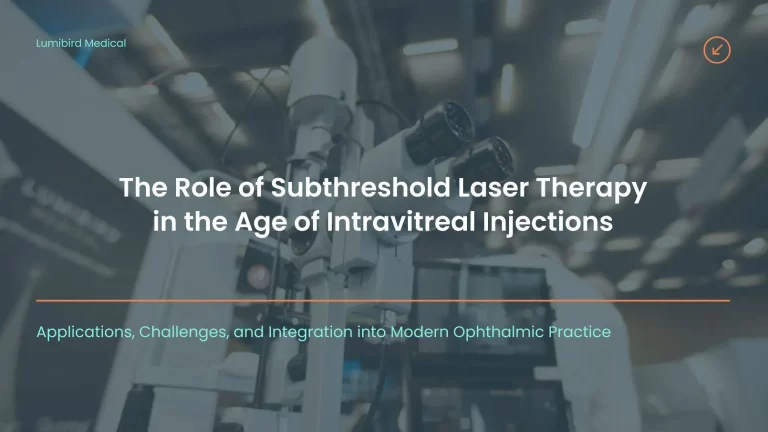
The Role of Subthreshold Laser Therapy in the Age of Intravitreal Injections
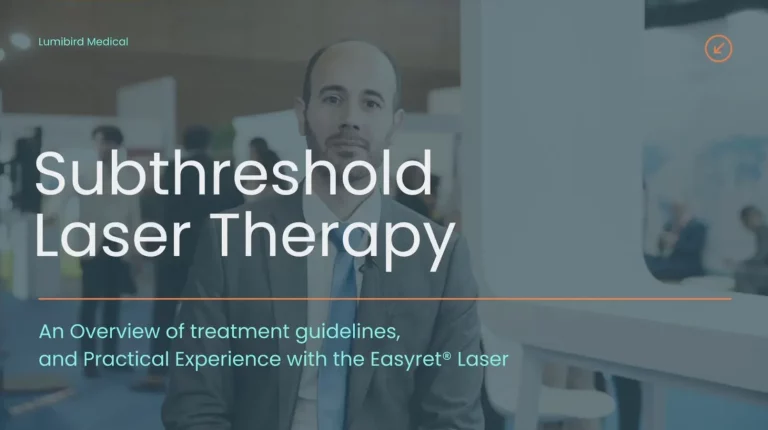
Subthreshold Laser Therapy: An Overview of Treatment Guidelines & Experience with the Easyret Laser
Diabetic Macular Edema (DME)
Diabetic retinopathy is the leading cause of visual loss and blindness in working age populations in the developed world. Diabetic macular edema (DME) is the leading cause of blindness in the diabetic population.
A recent pooled analysis from 35 population-based studies estimated that 93 million people worldwide have diabetic retinopathy, of whom 17 million (~18%) have proliferative DR, 21 million (~23%) have diabetic macular edema (DME), and 28 million (~20%) have sight-threatening DR9.
The treatment of DME has changed significantly in the past years. Nevertheless the best treatment option applicable to all DME patients still remains an open question. Although the introduction of anti-VEGF therapies has shown its safety and efficacy, the laser still plays an important role1011.
Yellow 577nm SubLiminal® laser therapy can be an excellent adjunct or alternative to anti-VEGF therapies.

Images courtesy of Alejandro Filloy Rius, MD. Ph.D
Tarragona, Spain
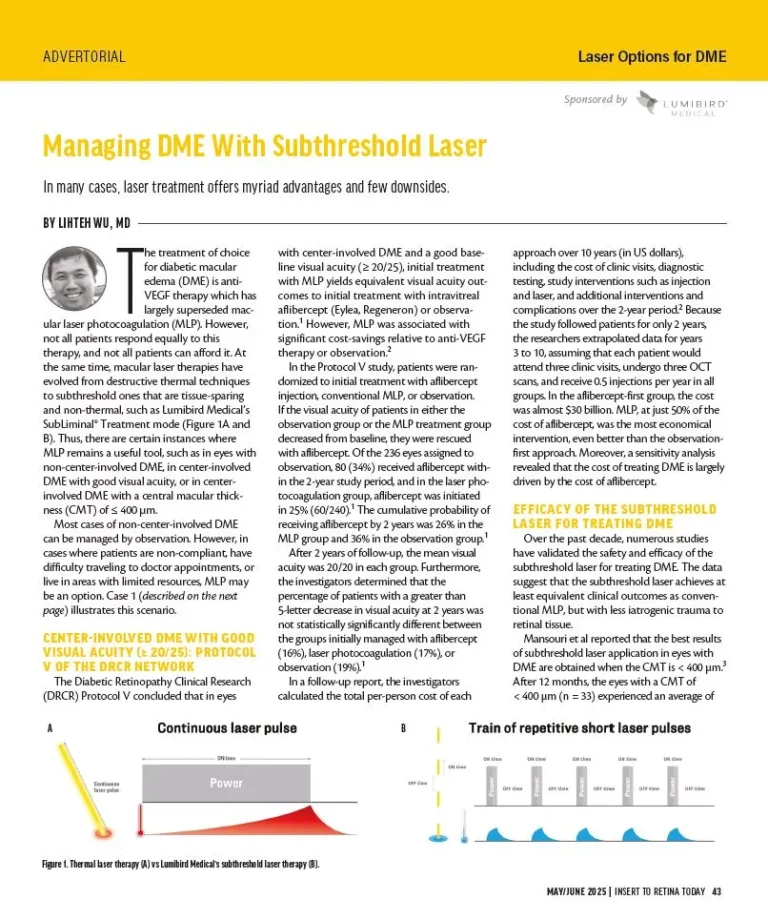
Managing DME With Subthreshold Laser

Lasers for Retina

Laser Remains an Effective Option for DME and CSCR Treatments
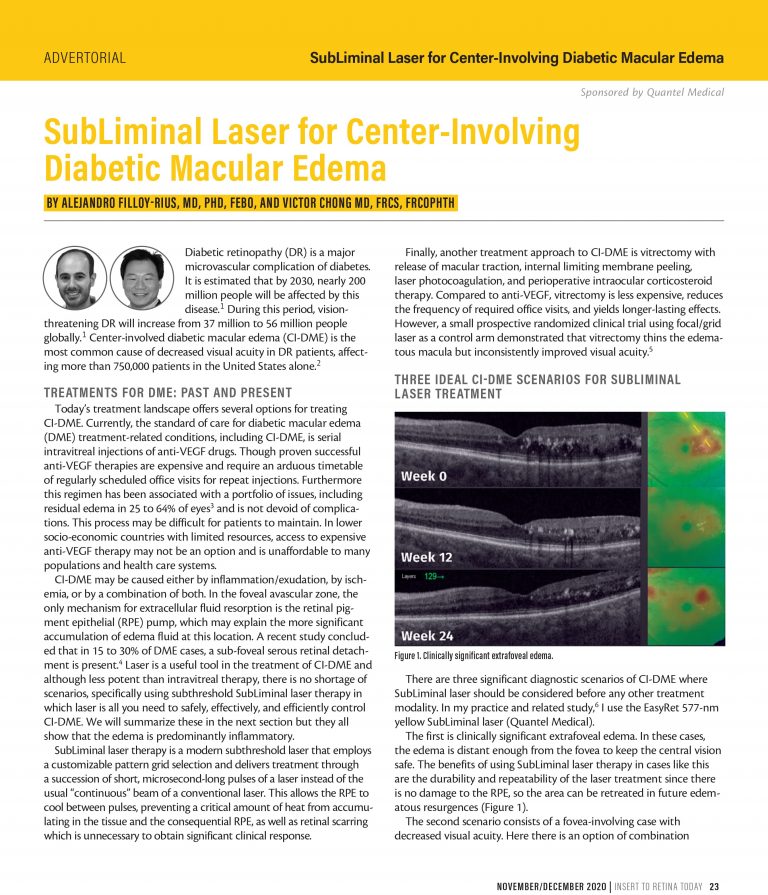
SubLiminal Laser for Center-Involving Diabetic Macular Edema
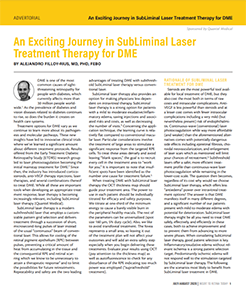
An Exciting Journey in SubLiminal Laser Treatment Therapy for DME
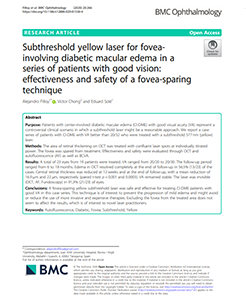
Subthreshold yellow laser for fovea-involving diabetic macular edema in a series of patients with good vision
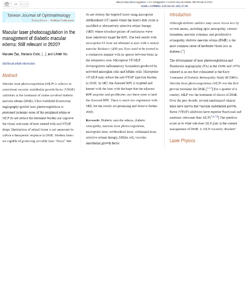
Macular laser photocoagulation in the management of diabetic macular edema: Still relevant in 2020?
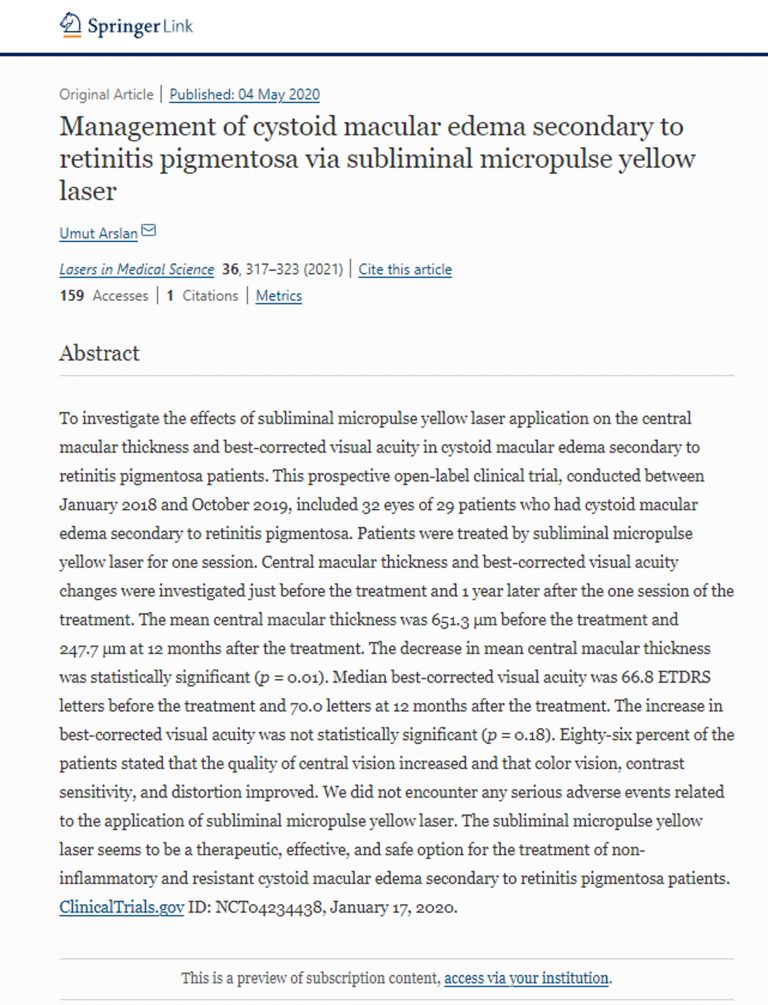
Management of cystoid macular edema secondary to retinitis pigmentosa via subliminal micropulse yellow laser
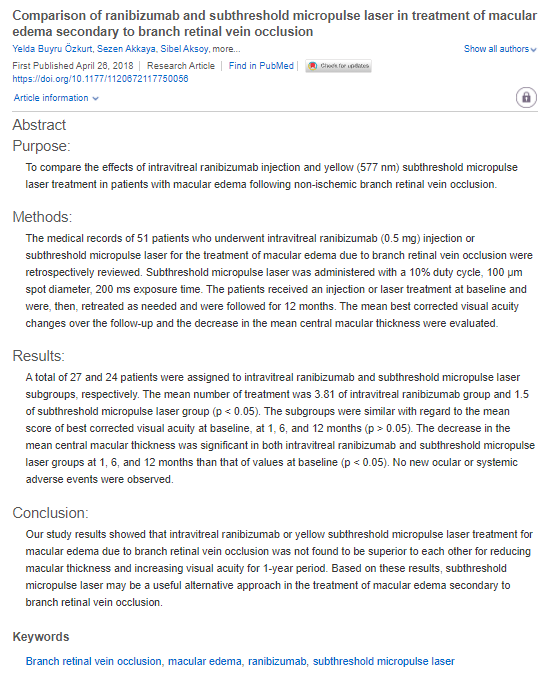
Comparison of ranibizumab and subthreshold micropulse laser in treatment of macular edema secondary to branch retinal vein occlusion

What is the role of Easyret subthreshold laser in macular diseases?
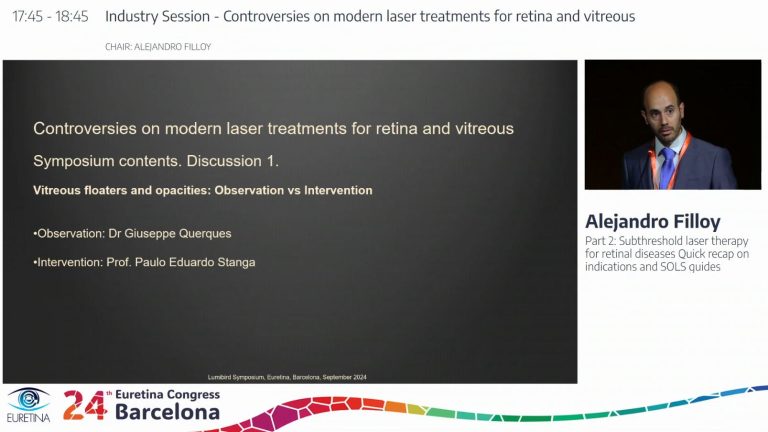
Controversies on Modern Laser Treatments for Retina and Vitreous
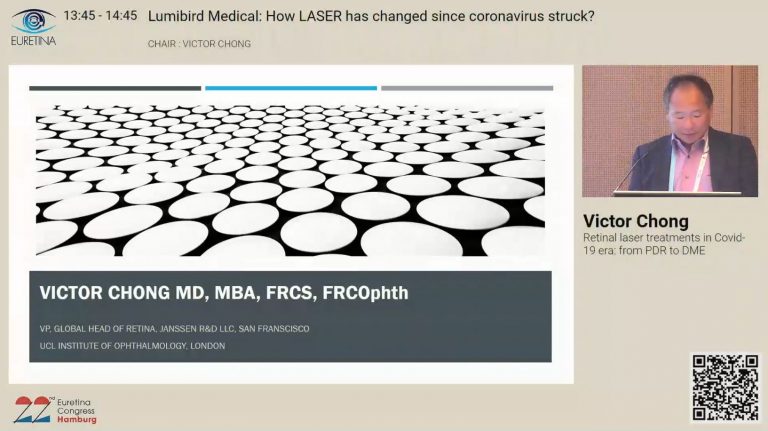
Retinal laser treatments in Covid 19 era: from PDR to DME
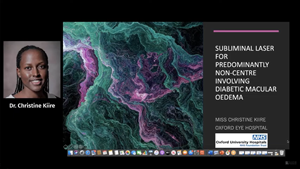
SubLiminal Laser for predominantly non-center involving DME?
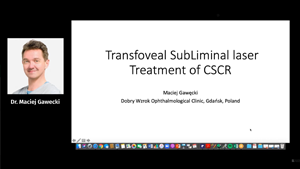
Transfoveal SubLiminal Laser treatment for CSC

SubLiminal laser for DME and CSC: when and how?

Fovea-Involving DME: Reasons for the subliminal approach

Our first year of lessons learnt with SubLiminal laser for CCSC and DME

The Role of Subthreshold Laser Therapy in the Age of Intravitreal Injections

Subthreshold Laser Therapy: An Overview of Treatment Guidelines & Experience with the Easyret Laser
Age-Related Macular Degeneration (ARMD)
Age-related macular degeneration is the world’s leading cause of irreversible blindness among elderly people.
Atrophic AMD (Dry AMD) affects approximately 80-90% of individuals with AMD.
In early AMD, small white or yellowish deposits, called drusen, form on the retina, beneath the macula, causing it to deteriorate or degenerate over time.
Hard drusen are small, well-demarcated lesions and can be seen in the healthy, aging population.
Soft drusen are large and there borders are less well defined (cotton-ball’ like). They are generally pathologic and are not found in young, healthy populations.
There is currently no treatment for drusen, nevertheless it has been observed clinically that subthreshold laser could make drusen disappear and prevent the progression of the pathology.
Clinical studies are currently ongoing regarding this topic.
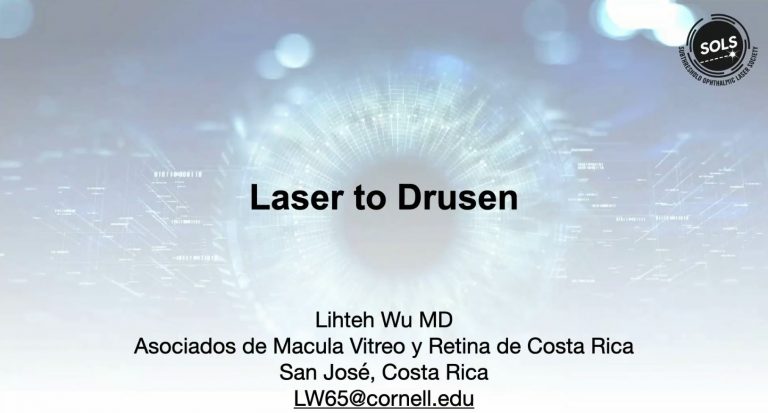
Subthreshold laser: a new hope for macular degeneration?
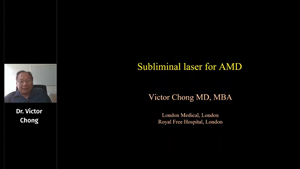
SubLiminal laser for AMD
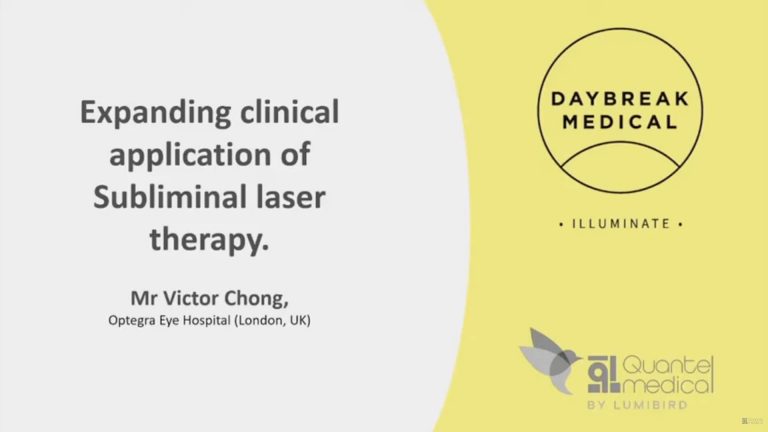
Expanding clinical application of SubLiminal laser therapy
Idiopathic Polypoidal choroidal vasculopathy (IPCV)
Idiopathic Polypoidal choroidal vasculopathy (IPCV) is a disease of the choroidal vasculature.
It is characterised by the presence of aneurysmal polypoidal lesions and branching vascular network, in the choroidal vasculature. This can lead to serous or haemorrhagic pigment epithelial detachment (PED), episodes of exudative retinal detachment and subretinal exudation and haemorrhage.
It is considered a variant of neovascular AMD.
IPCV is a relatively common in Asian and African American populations, affecting both sexes .
Evidence supports that:
- Symptomatic patients with IPCV can have complete regression without severe vision loss with photodynamic therapy (PDT) and anti-VEGF treatment.
- 577nm SubLiminal laser can be used to supplement treatment in IPCV cases with suboptimal response to anti-VEGF treatment.
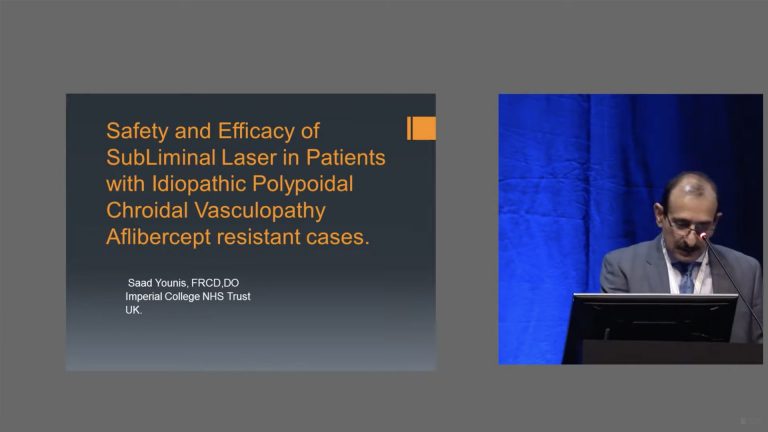
Efficacy of SubLiminal laser in IPCV Aflibercept resistant cases
Physicians
Talk about SubliminalLaser Therapy


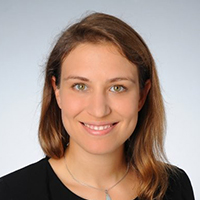


Bibliography
Central serous chorioretinopathy (CSCR) is a common retinal cause of vision loss. This review surveys the epidemiology, risk factors, clinical presentation, natural history and pathophysiology of CSCR. Studies suggest an annual incidence rate of 10 per 100 000 in men, with CSCR occurring six times more commonly in men compared with women. Most acute CSCR cases resolve spontaneously within 2–3 months. Prognosis is highly dependent on presenting visual acuity; patients with initial visual acuities of 6/6 remain at that level, while patients with initial visual acuities of less than 6/9 recover on average two to three Snellen lines over the next few years. The main risk factors for CSCR are systemic corticosteroid use, type A personality, pregnancy and endogenous Cushing’s syndrome. The pathophysiology of CSCR remains obscure, although disorders in both the choroidal circulation and retinal pigment epithelium are implicated.
Central serous chorioretinopathy (CSC) is a disease of the retina characterized by serous detachment of the neurosensory retina secondary to one or more focal lesions of the retinal pigment epithelium (RPE). CSC occurs most frequently in mid-life and more often in men than in women. Major symptoms are blurred vision, usually in one eye only and perceived typically by the patient as a dark spot in the centre of the visual field with associated micropsia and metamorphopsia. Normal vision often recurs spontaneously within a few months. The condition can be precipitated by psychosocial stress and hypercortisolism. Ophthalmoscopic signs of CSC range from mono- or paucifocal RPE lesions with prominent elevation of the neurosensory retina by clear fluid – typical of cases of recent onset – to shallow detachments overlying large patches of irregularly depigmented RPE.
Data are presented from 27 patients (34 eyes) with central serous choroidopathy who were followed up for an average of 23 months without therapeutic intervention. The detachment completely resolved in all cases. The average duration of detachment was three months. In all eyes, the visual acuity returned to 20/40 or better, and in all but two eyes, the final visual acuity was 20/30 or better. Central serous choroidopathy is essentially a benign and self-limited disorder, and treatment by photocoagulation is seldom needed.
The Wilmer Retinal Vascular Center’s experience with central serous chorioretinopathy from 1970 to the end of 1979 was reviewed and compared with previous studies. Retrospective analysis of 73 patients seen at follow-up suggests no clinically significant effect of focal argon laser photocoagulation on final visual acuity or recurrence rate. Patients with initial visual acuity of 20/20 remained at that level, and patients with initial visual acuity of less than 20/30 gained, on average, two to three Snellen lines at follow-up. Approximately one-third of both untreated and treated patients had recurrence or presumed persistence during the follow-up period. With the inclusion of episodes that occurred before the first Wilmer Institute visit about half of each group had recurrence or presumed persistence. Recurrences were most often due to leakage from a site within one disc diameter of the original site of leakage.
In a prospective randomised trial of argon laser photocoagulation in the management of central serous retinopathy, long-term follow-up (6.4 to 12.1 years) revealed no evidence that treatment significantly influenced the visual outcome as measured by the Snellen chart and by the Farnsworth-Munsell 100-hue test. Treatment did not reduce either the recurrence rate or the prevalence of chronic disease. Complications of treatment were uncommon. The justification for argon laser photocoagulation appears to be limited to the hastening of symptomatic relief by earlier resolution of serous detachment.
Background: To evaluate risk factors for the recurrence of serous macular detachment in untreated patients with central serous chorioretinopathy (CSC).
Methods: Retrospective review of untreated CSC patients with a follow-up of ≥3 years. Patient demographics, visual outcome and risk factors for the recurrence of CSC were analyzed.
Results: Seventy-three eyes of 73 patients were included, and the mean age was 44.6 years. At baseline, the mean logMAR best corrected visual acuity (BCVA) was 0.30. After a mean follow-up of 72 months, the mean final logMAR BCVA was 0.32. The difference between the final and baseline BCVAs was not statistically significant (p = 0.79). At the last follow-up, 9 (12.3%) eyes showed improved vision of ≥2 lines, and 12 (16.4%) showed a worsening of ≥2 lines. During follow-up, 38 (52.1%) patients experienced ≥1 episode of CSC recurrence. Multivariate Cox regression analysis showed that patients with a history of psychiatric illness (adjustment disorder and depression) were associated with an increased risk of CSC recurrence (hazard ratio = 3.5, p = 0.011).
Conclusions: The long-term visual prognosis of CSC is fair without treatment, and a significant proportion of patients developed recurrence of CSC. A history of psychiatric illness is associated with an increased risk of CSC recurrence.
Purpose: To assess treatment with a 577-nm subthreshold micropulse laser (SML) in patients with chronic central serous chorioretinopathy (cCSC).
Methods: This retrospective study included 38 patients treated with a 577-nm SML (Supra Scan; Quantel Medical) for cCSC. We included a subgroup of 18 patients with persistent subretinal fluid (SRF) after photodynamic therapy (PDT). Assessment included visual acuity (VA), central retinal thickness (CRT) and resolution of SRF.
Results: At the last follow-up (mean 5 months), 74% of patients responded to therapy. The CRT decreased after treatment (mean CRT -115 µm, p < 0.001) and VA improved (mean logMAR -0.06, p = 0.039). No laser burns were detected with any imaging modality. In the subgroup of patients resistant to PDT, 61% of patients responded to therapy with a decrease in CRT (mean CRT -75 µm, p = 0.019).
Conclusions: The 577-nm SML is an effective treatment for cCSC even in patients without sufficient improvement after PDT.
Purpose: To compare the short-term treatment outcome of the 577 nm subthreshold micropulse laser (SML) and half-dose photodynamic therapy (PDT) in patients with chronic central serous chorioretinopathy (cCSC) and persistent subretinal fluid (SRF).
Methods: This retrospective study included 100 eyes of 100 consecutive patients who were treated with the 577 nm SML (Supra Scan, Quantel Medical) (n=42) or half-dose PDT (n=58) for cCSC. The treatment was applied at the leakage sites in the fluorescein and indocyanine green angiography. The treatment success was evaluated 6 weeks after treatment using best-corrected visual acuity, central retinal thickness, and resolution of SRF in spectral domain optical coherence tomography.
Results: Patients showed treatment response more often in the SML group compared with the PDT group (treatment response after SML: 33 eyes (79%), PDT: 34 eyes (59%), P=0.036, χ2 test). The CRT decreased significantly after both treatments (mean CRT before SML: 445±153 μm, after SML: 297±95, Po0.001; mean CRT before PDT: 398±88 μm, after PDT: 322±93 μm, Po0.001, Wilcoxon’s signed-rank test). The decrease in CRT was statistically significantly higher in the SML group (decrease in CRT after SML: − 148±163 μm, after PDT: −76±104 μm, P=0.041, Mann–Whitney U-test).
Conclusions: Both the half-dose PDT and the 577 nm SML are potent treatments for cCSC with persistent SRF. More patients showed treatment response to the SML treatment and SML leads to a greater decrease in CRT.
Objective: To examine the global prevalence and major risk factors for diabetic retinopathy (DR) and vision-threatening diabetic retinopathy (VTDR) among people with diabetes.
Research design and methods: A pooled analysis using individual participant data from population-based studies around the world was performed. A systematic literature review was conducted to identify all population-based studies in general populations or individuals with diabetes who had ascertained DR from retinal photographs. Studies provided data for DR end points, including any DR, proliferative DR, diabetic macular edema, and VTDR, and also major systemic risk factors. Pooled prevalence estimates were directly age-standardized to the 2010 World Diabetes Population aged 20-79 years.
Results: A total of 35 studies (1980-2008) provided data from 22,896 individuals with diabetes. The overall prevalence was 34.6% (95% CI 34.5-34.8) for any DR, 6.96% (6.87-7.04) for proliferative DR, 6.81% (6.74-6.89) for diabetic macular edema, and 10.2% (10.1-10.3) for VTDR. All DR prevalence end points increased with diabetes duration, hemoglobin A(1c), and blood pressure levels and were higher in people with type 1 compared with type 2 diabetes.
Conclusions: There are approximately 93 million people with DR, 17 million with proliferative DR, 21 million with diabetic macular edema, and 28 million with VTDR worldwide. Longer diabetes duration and poorer glycemic and blood pressure control are strongly associated with DR. These data highlight the substantial worldwide public health burden of DR and the importance of modifiable risk factors in its occurrence. This study is limited by data pooled from studies at different time points, with different methodologies and population characteristics.
Subthreshold, or tissue-sparing, laser therapy is a subject of interest to retinal specialists worldwide. Today, micropulse technology with 810 nm and 577 nm lasers is used to produce a therapeutic treatment without inducing intraretinal damage detectable on clinical examination during or after treatment. The controlled laser delivery of micropulse technology affords treatment options for diabetic macular edema(DME), proliferative diabetic retinopathy (PDR), central erous chorio retinopathy (CSR), macular edema secondary to branch retinal vein occlusion (BRVO), and even glaucoma. This review will explain micropulse technology and focus on its benefits and challenges in the treatment of retinal disorders.
Purpose: This pilot study aimed to evaluate the efficacy and safety of subthreshold micropulse yellow (577-nm) laser photocoagulation (SMYLP) in the treatment of diabetic macular edema (DME).
Methods: We reviewed 14 eyes of 12 patients with DME who underwent SMYLP with a 15% duty cycle at an energy level immediately below that of the test burn. The laser exposure time was 20 ms and the spot diameter was 100 µm. Laser pulses were administered in a confluent, repetitive manner with a 3 × 3 pattern mode.
Results: The mean follow-up time was 7.9 ± 1.6 months. The baseline-corrected visual acuity was 0.51 ± 0.42 logarithm of the minimum angle of resolution (logMAR), which was improved to 0.40 ± 0.35 logMAR (p = 0.025) at the final follow-up. The central macular thickness at baseline was 385.0 ± 111.0 µm; this value changed to 327.0 ± 87.7 µm (p = 0.055) at the final follow-up.
Conclusions: SMYLP showed short-term efficacy in the treatment of DME and did not result in retinal damage. However, prospective, comparative studies are needed to better evaluate the efficacy and safety of this treatment.
Keywords: Diabetic retinopathy; Laser therapy; Macular edema.

